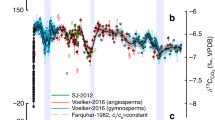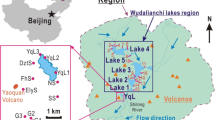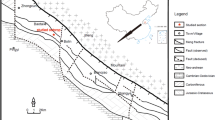Abstract
Fossil Ginkgophyta are one of the most widely used indicators for estimating the paleoatmospheric CO2 levels from the Triassic to present day. There are quite a few CO2 estimates for the Triassic to Jurassic interval; however, the data from China are still limited. In this study, two fossil Ginkgoites species, Ginkgoites magnifolius Du Toit and Ginkgoites obrutschewii (Seward) Seward, are described based on recent collections from the Upper Triassic and Middle Jurassic in Huating County, Gansu Province, Northwest China. The fossil leaf morphology and epidermal structure were studied and the stomatal parameters were analyzed for the reconstruction of paleoatmospheric CO2 concentrations. The paleoatmospheric CO2 concentration during the Late Triassic of China is estimated for the first time based on fossil material from Gansu. Our fossils yield paleo-CO2 values of 1962 ppmv in the Late Triassic and 1320 ppmv in the Middle Jurassic. Compared with previous estimates of atmospheric CO2 concentration based on stomatal parameter of fossil Ginkgo/Ginkgoites from Northwest China, the change of Jurassic paleo-CO2 levels accord with the trend of CO2 concentration proposed by GEOCARB III and Crustal Production models. The results demonstrate that the paleo-CO2 of the Late Triassic was higher than that of the Early to Middle Jurassic; but an increasing trend of paleo-CO2 could be detected from the Early to the Middle Jurassic. However, the GEOCARBSULF model indicates a decreasing trend during this interval. Therefore, the present data provide an independent check for the paleo-CO2 value estimation based on isotopic analysis.
Kurzfassung
Fossile Ginkgophyta gehören zu den am häufigsten verwendeten Indikatoren für paläoatmosphärische CO2-Konzentration von der Trias bis heute. Es gibt viele Berechnungen für die CO2-Konzentrationen im Zeitintervall von der Trias bis zum Jura, aber Daten aus China sind noch begrenzt. In vorliegender Studie werden zwei fossile Ginkgoites-Arten, Ginkgoites magnifolius Du Toit und Ginkgoites obrutschewii (Seward) Seward, anhand von neuesten Aufsammlungen aus der Oberen Trias und dem Mittleren Jura in Nordwest-China (Kreis Huating der Provinz Gansu) beschrieben. Die Blattmorphologie und Epidermalstruktur wurden untersucht und die stomatären Parameter analysiert, um die paläoatmosphärischen CO2-Konzentrationen zu rekonstruieren. Die paläoatmosphärischen CO2-Konzentrationen während der Oberen Trias von China wurden hiermit erstmalig anhand von Fossilmaterial aus Gansu berechnet. Unsere Fossilien liefern Paläo-CO2-Konzentrationen von 1962 ppmv in der Oberen Trias und 1320 ppmv im Mittleren Jura. Im Vergleich mit früheren Berechnungen basierend auf stomatären Parametern von fossilen Ginkgo/Ginkgoites-Vertretern aus Nordwest-China stimmen die Änderungen in der jurassischen Paläo-CO2-Konzentration mit dem durch GEOCARB III und Crustal Production-Modellen aufgestellten Trend der CO2-Konzentration überein. Die Ergebnisse zeigen eine höhere Paläo-CO2-Konzentration in der Oberen Trias als im Unteren und Mittleren Jura, jedoch wurde ein interessanter Trend der Paläo-CO2-Konzentration vom Unteren bis Mittleren Jura festgestellt. Ein GEOCARBSULF-Modell zeigt einen Rückgang in diesem Zeitintervall. Daher liefern die vorliegenden Daten eine unabhängige Kontrolle der Berechnungen der Paläo-CO2-Werte basierend auf Isotopenanalysen.




Similar content being viewed by others
References
Beerling, D.J., J.A. Lake, R.A. Berner, L.J. Hickey, D.W. Taylor, and D.L. Royer. 2002. Carbon isotope evidence implying high O2/CO2 ratios in the Permo-Carboniferous atmosphere. Geochimica et Cosmochimica Acta 66(21): 3757–3767.
Beerling, D.J., J.C. McElwain, and C.P. Osborne. 1998. Stomata1 responses of the “living fossil” Ginkgo biloba L. to changes in atmospheric CO2 concentrations. J Exp Bot 49(326): 1603–1607.
Bergman, N.M., T.M. Lenton, and A.J. Watson. 2004. COPSE: a new model of biogeochemical cycling over phanerozoic time. Am J Sci 304: 397–437.
Berner, R.A. 1994. GEOCARB II: a revised model of atmospheric CO2 over Phanerozoic time. Am J Sci 294: 56–91.
Berner, R.A. 2006. GEOCARBSULF: a combined model for Phanerozoic atmospheric O2 and CO2. Geochimica et Cosmochimica Acta 70: 5653–5664.
Berner, R.A., and Z. Kothavala. 2001. GEOCARB III: a revised of atmospheric CO2 over Phanerozoic. Am J Sci 301: 182–204.
Bonis, N.R., J.H.A. Van Konijnenburg-Van Cittert, and W.M. Kürschner. 2010. Changing CO2 conditions during the end-Triassic inferred from stomatal frequency analysis on Lepidopteris ottonis (Goeppert) Schimper and Ginkgoites taeniatus (Braun) Harris. Palaeogeogr Palaeoclimatol Palaeoecol 295: 146–161.
Breecker, D.O., Z.D. Sharp, and L.D. McFadden. 2010. Atmospheric CO2 concentrations during ancient greenhouse climates were similar to those predicted for AD 2100. PNAS 107(2): 576–580.
Cerling, T.E. 1991. Carbon dioxide in the atmosphere: evidence from Cenozoic and Mesozoic paleosols. Am J Sci 291: 377–400.
Chen, L.Q., C.S. Li, W.G. Chaloner, D.J. Beerling, Q. Sun, M.E. Collinson, and P.L. Mitchell. 2001. Assessing the potential for the stomatal characters of extant and fossil Ginkgo leaves to signal atmospheric CO2 change. Am J Bot 88: 1309–1315.
Chen, Y., S.Y. Duan, and Y.C. Zhang. 1987. Late Triassic Qinghe flora of Sichuan. Bot Res 2: 83–157. (in Chinese with English abstract).
Cleveland, D.M., L.C. Nordt, S.I. Dworkin, and S.C. Atchley. 2008. Pedogenic carbonate isotopes as evidence for extreme climatic events preceding the Triassic–Jurassic boundary: implications for the biotic crisis? Geol Soc Am Bull 120: 1408–1415.
Ding, S.T., B.N. Sun, J.Y. Wu, and X.C. Li. 2010. Cuticular composition and isotope characteristics of Jurassic Phoencopsis (Phoencopsis) angustifolia Heer from Huating in Gansu province, China. J Lanzhou University (Nat Sci) 46(1): 14–21. (in Chinese with English abstract).
Donnadieu, Y., Y. Goddéris, R. Pierrehumbert, G. Dromart, F. Fluteau, and R. Jacob. 2006. A GEOCLIM simulation of climatic and biogeochemical consequences of Pangea breakup. Geochem Geophys Geosystems 7(11): Q11019. doi:10.1029/2006GC001278.
Du Toit, A.L. 1927. The fossil flora of the Upper Karroo Beds. Ann S Afr Mus 22: 289–420.
Ekart, D.D., T.E. Cerling, I.P. Montañez, and N.J. Tabor. 1999. A 400 million year carbon isotope record of pedogenic carbonates: implications for paleoatmospheric carbon dioxide. Am J Sci 299: 805–827.
Franks, P.J., D.L. Royer, D.J. Beerling, P.K. Van de Water, D.J. Cantrill, M.M. Barbour, and J.A. Berry. 2014. New constraints on atmospheric CO2 concentration for the Phanerozoic. Geophys Res Lett 41: 4685–4694.
Goddéris, Y., Y. Donnadieu, C. de Vargas, R.T. Pierrehumbert, G. Dromart, and B. van de Schootbrugge. 2008. Causal or casual link between the rise of nannoplankton calcification and a tectonically-driven massive decrease in Late Triassic atmospheric CO2? Earth Planet Sci Lett 267(1–2): 247–255.
Haworth, M., A. Gallagher, E. Sum, M. Hill-Donnelly, M. Steinthorsdottir, and J. McElwain. 2014. On the reconstruction of plant photosynthetic and stress physiology across the Triassic–Jurassic boundary. Turk J Earth Sci 23: 321–329.
Hesselbo, S.P., H.S. Morgans-Bell, J.C. McElwain, P.M. Rees, S.A. Robinson, and C.E. Ross. 2003. Carbon-cycle perturbation in the Middle Jurassic and accompanying changes in the terrestrial paleoenvironment. J Geol 111(3): 259–276.
Huang, Z., and H. Zhou. 1980. Fossil plants. Palaeobotany. Institute of Geology, Chinese Academy of Geosciences: Mesozoic Stratigraphy and Palaeontology of the Shaanxi, Gansu and Ningxia Basin. I., 43–198. Beijing: Geological Publishing House. (in Chinese).
Masterson, J. 1994. Stomatal size in fossil plants: evidence for polyploidy in majority of angiosperms. Science 264: 421–423.
McElwain, J.C. 1998. Do fossil plants signal palaeoatmospheric CO2 concentration in the geological past? Philos Trans R Soc Lond B 353: 83–96.
McElwain, J.C., and W.G. Chaloner. 1995. Stomatal density and index of fossil plants track atmospheric carbon dioxide in the Paleozoic. Ann Bot 76: 389–395.
McElwain, J.C., and W.G. Chaloner. 1996. The fossil cuticle as a skeletal record of environmental change. Palaios 11: 376–388.
McElwain, J.C., D.J. Beerling, and F.I. Woodward. 1999. Fossil plants and global warming at the Triassic–Jurassic boundary. Science 285: 1386–1390.
McElwain, J.C., M.E. Popa, S.P. Hesselbo, M. Haworth, and F. Surlyk. 2007. Macroecological responses of terrestrial vegetation to climate and atmospheric change across the Triassic/Jurassic boundary in East Greenland. Paleobiology 33: 547–573.
Nosova, N., J.W. Zhang, and C.S. Li. 2011. Revision of Ginkgoites obrutschewii (Seward) Seward (Ginkgoales) and the new material from the Jurassic of Northwestern China. Rev Palaeobot Palynol 166: 286–294.
Prochnow, S.J., L.C. Nordt, S.C. Atchley, and M.R. Hudec. 2006. Multi-proxy paleosol evidence for middle and late Triassic climate trends in eastern Utah. Palaeogeogr Palaeoclimatol Palaeoecol 232: 53–72.
Quan, C., C. Sun, Y. Sun, and G. Sun. 2009. High resolution estimates of paleo-CO2 levels through the Campanian (Late Cretaceous) based on Ginkgo cuticles. Cretac Res 30(2): 424–428.
Retallack, G.J. 2001. A 300 million-year record of atmospheric carbon dioxide from fossil plant cuticles. Nature 411: 287–290.
Royer, D.L. 2006. CO2-forced climate thresholds during the Phanerozoic. Geochimica et Cosmochimica Acta 70: 5665–5675.
Royer, D.L. 2008. Linkages between CO2, climate, and evolution in deep time. PNAS 105(2): 407–408.
Royer, D.L. 2010. Fossil soils constrain ancient climate sensitivity. PNAS 107(2): 517–518.
Royer, D.L., R.A. Berner, I.P. Montañez, N.J. Tabor, and D.J. Beerling. 2004. CO2 as a primary driver of Phanerozoic climate. GSA Today 14(3): 4–10.
Royer, D.L., S.L. Wing, D.J. Beerling, D.W. Jolley, P.L. Koch, L.J. Hickey, and R.A. Berner. 2001. Paleobotanical evidence for near present-day levels of atmospheric CO2 during part of the Tertiary. Science 292: 2310–2313.
Royer, D.L., Y. Donnadieu, J. Park, J. Kowalczyk, and Y. Goddéris. 2014. Error analysis of CO2 and O2 estimates from the long-term geochemical model GEOCARBSULF. Am J Sci 314: 1259–1283.
Salisbury, E.J. 1927. On the causes and ecological significance of stomatal frequency, with special reference to the Woodland flora. Philos Trans R Soc Lond B 216: 1–65.
Schaller, M.F., J.D. Wright, and D.V. Kent. 2014. A 30 Myr record of Late Triassic atmospheric pCO2 variation reflects a fundamental control of the carbon cycle by changes in continental weathering. Geol Soc Am Bull 127: 661–671.
Schaller, M.F., J.D. Wright, D.V. Kent, and P.E. Olsen. 2012. Rapid emplacement of the Central Atlantic Magmatic Province as a net sink for CO2. Earth Planet Sci Lett 323–324: 27–39.
Seward, A.C. 1911. Jurassic Plants from Chinese Dzungaria. Mémoires du Comité Géologique 75, St.-Pétersbourg, 1–61.
Seward, A.C. 1919. Fossil Plants, vol. 4. Cambridge: Cambridge University Press.
Shaviv, N.J., and J. Veizer. 2003. Celestial driver of Phanerozoic climate? GSA Today 13(7): 4–10.
Steinthorsdottir, M., and V. Vajda. 2015. Early Jurassic (late Pliensbachian) CO2 concentrations based on stomatal analysis of fossil conifer leaves from eastern Australia. Gondwana Res 27(3): 932–939.
Steinthorsdottir, M., F.I. Woodward, F. Surlyk, and J.C. McElwain. 2012. Deep-time evidence of a link between elevated CO2 concentrations and perturbations in the hydrological cycle via drop in plant transpiration. Geology 40(9): 815–818.
Steinthorsdottir, M., K.L. Bacon, M.E. Popa, L. Bochner, and J.C. McElwain. 2011a. Bennettitalean leaf cuticle fragments (here Anomozamites and Pterophyllum) can be used interchangeably in stomatal frequency-based palaeo-CO2 reconstructions. Palaeontology 54: 867–882.
Steinthorsdottir, M.M., A.J. Jeram, and J.C. McElwain. 2011b. Extremely elevated CO2 concentrations at the Triassic/Jurassic boundary. Palaeogeogr Palaeoclimatol Palaeoecol 308: 418–432.
Sun, B.N. 1986. A preliminary study of Middle Jurassic fossil plants from Yaojie coal-field of Lanzhou. J Lanzhou University (Nat Sci) 228(1): 113–118. (in Chinese with English abstract).
Sun, B.N. 1992. The assemblage succession of the Early Mesozoic fossil plants from Jingyuan coal field in Gansu. J Lanzhou University (Nat Sci) 28(8): 163–167. (in Chinese with English abstract).
Sun, B.N., D.F. Yan, S.P. Xie, and Y.D. Wang. 2009. Stomata and carbon isotope analysis of fossil plants and their applications. Beijing: Science Press. (in Chinese).
Sun, B.N., L. Xiao, S.P. Xie, S.H. Deng, Y.D. Wang, H. Jia, and S. Turner. 2007. Quantitative analysis of paleoatmospheric CO2 level based on stomatal characters of fossil Ginkgo from Jurassic to Cretaceous in China. Acta Geologica Sinica 81(6): 931–939.
Sun, B.N., S.P. Xie, D.F. Yan, and P.Y. Cong. 2008. Fossil plant evidence for Early and Middle Jurassic paleoenvironmental changes in Lanzhou area, Northwest China. Palaeoworld 17: 215–221.
Sze, H.C. 1956. Older Mesozoic flora from the Yenchang formation, northern Shensi. Palaeontologia Sinica (New series A) 5: 1–217.
Sze, H.C., and H.H. Lee. 1963. Fossil Plants from China 2. Mesozoic Plants from China. Beijing: Science Press. (in Chinese).
Tanner, L.H., J.F. Hubert, B.P. Coffey, and D.P. Mclnerney. 2001. Stability of atmospheric CO2 levels across the Triassic/Jurassic boundary. Nature 411: 675–677.
Wang, D. 2005. Yanan Formation depositional environment analysis in Huating Mining Area. Coal Geol China 17(5): 22–24. (in Chinese with English abstract).
Wang, Y., C. Huang, B. Sun, C. Quan, J. Wu, and Z. Lin. 2014. Paleo-CO2 variation trends and the Cretaceous greenhouse climate. Earth-Sci Rev 129: 136–147.
Williford, K.H., K. Grice, A. Holman, and J.C. McElwain. 2014. An organic record of terrestrial ecosystem collapse and recovery at the Triassic–Jurassic boundary in East Greenland. Geochimica et Cosmochimica Acta 127: 251–263.
Xie, S., B. Sun, D. Yan, L. Xiao, and L. Wei. 2006. Leaf cuticular characters of Ginkgo and implications for paleoatmospheric CO2 in the Jurassic. Prog Nat Sci 16: 258–263.
Xie, S., D. Yan, L. Wei, P. Cong, and B. Sun. 2005. A stomatal approach for accurate reconstruction of paleoatmospheric CO2 concentration. Acta Palaeontologica Sinica 44(3): 464–471. (in Chinese with English abstract).
Yan, D.F., and B.N. Sun. 2004. The discovery of Solenites murrayana L. et. H. in Yaojie coal field, Gansu and its geological significance. J Lanzhou University (Nat Sci) 40(3): 84–88. (in Chinese with English abstract).
Yan, D.F., B.N. Sun, S.P. Xie, X.C. Li, and W.W. Wen. 2009. Response to paleoatmospheric CO2 concentration of Solenites vimineus (Phillips) Harris (Ginkgophyta) from the Middle Jurassic of the Yaojie Basin, Gansu Province, China. Sci China, Ser D 52(12): 2029–2039.
Yan, T.S. 2006. Study on Upper Triassic Flora and Paleaogeography in Baojishan, Gansu Province. Geogr Geo-Inf Sci 22(1): 103–108. (in Chinese with English abstract).
Yapp, C.J., and H. Poths. 1996. Carbon isotopes in continental weathering environments and variations in ancient atmospheric CO2 pressure. Earth Planet Sci Lett 137: 71–82.
Zhou, Z. 2003. Mesozoic Ginkgoaleans: phylogeny, classification and evolutionary trends. Acta Botanica Yunnanica 25(4): 377–396. (in Chinese with English abstract).
Acknowledgments
We thank two reviewers and Dr. Mike Pole (University of Queensland, Australia/Nanjing Institute of Geology and Palaeontology, Chinese Academy of Sciences, China) for constructive suggestion and comments of the manuscript. This study was jointly supported by State Key Programme of Basic Research of Ministry of Science and Technology, China (973 Programme) (Grant No. 2012CB822003), National Natural Science Foundation of China (Grant Nos. 41572014, 41272010, 41302009, 41402008), China Postdoctoral Science Foundation (Grant No. 2011M500960), the Innovation Project of CAS (Grant No. KZCX-2-YW-154), Team Program of Scientific Innovation and Interdisciplinary Cooperation of CAS, Natural Science Foundation of Gansu Province, China (Grant No. 1506RJZA210), and Fundamental Research Funds for the Central Universities (Grant No. lzujbky-2015-131). This is a contribution to UNESCO-IUGS International Geoscience Program IGCP 632.
Author information
Authors and Affiliations
Corresponding author
Rights and permissions
About this article
Cite this article
Wu, Jy., Ding, St., Li, Qj. et al. Reconstructing paleoatmospheric CO2 levels based on fossil Ginkgoites from the Upper Triassic and Middle Jurassic in Northwest China. PalZ 90, 377–387 (2016). https://doi.org/10.1007/s12542-016-0300-1
Received:
Accepted:
Published:
Issue Date:
DOI: https://doi.org/10.1007/s12542-016-0300-1




